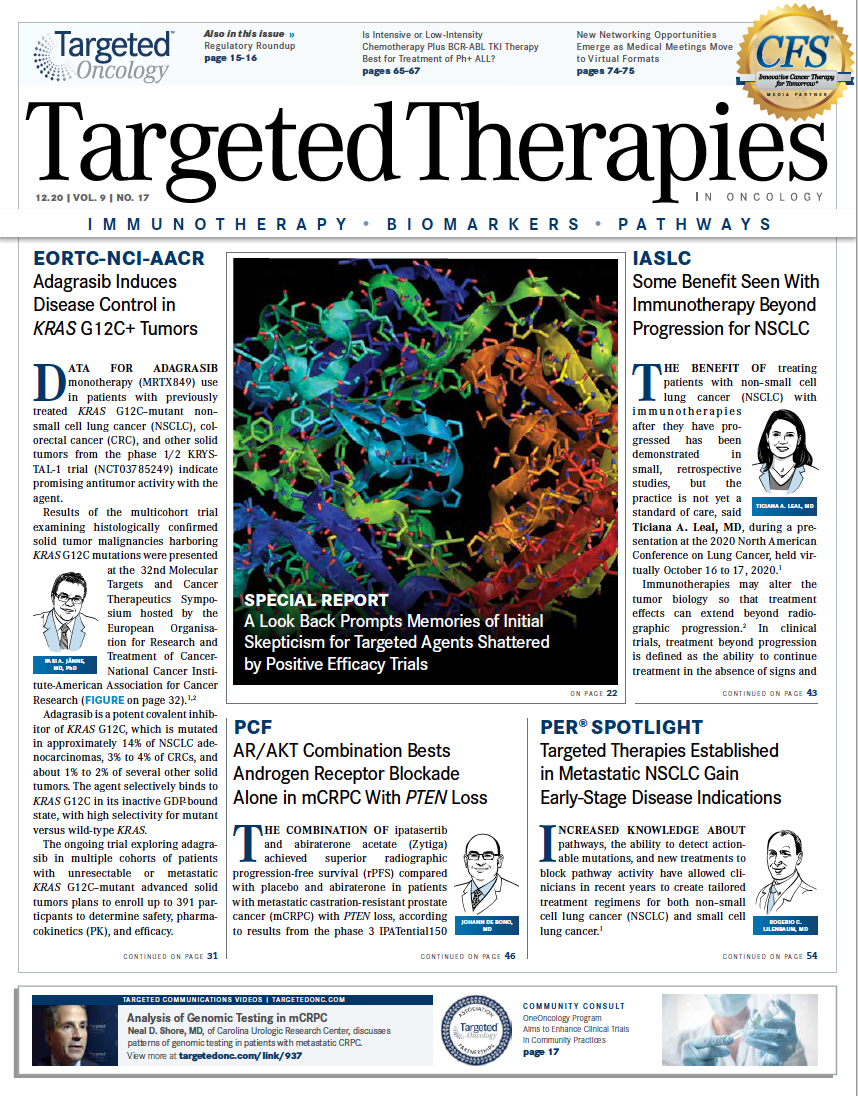Targeted Therapies Established in Metastatic NSCLC Gain Early-Stage Disease Indications
The emergence of tyrosine kinase inhibitors in early-stage disease is a late practice-changing development, said Roger C. Lilenbaum, MD.
Rogerio C. Lilenbaum, MD

Increased knowledge about pathways, the ability to detect actionable mutations, and new treatments to block pathway activity have allowed clinicians in recent years to create tailored treatment regimens for both non–small cell lung cancer (NSCLC) and small cell lung cancer.1
The emergence of tyrosine kinase inhibitors in early-stage disease is a late practice-changing development, Roger C. Lilenbaum, MD, director of Banner MD Anderson Cancer Center in Phoenix, Arizona, said during an interview with Targeted Therapies in Oncology. He noted the results of the phase 3 ADAURA trial (NCT02511106), which evaluated osimertinib (Tagrisso) for early-stage EGFR-mutated NSCLC.2
Following complete tumor resection in patients, osimertinib reduced the risk for central nervous system (CNS) death or progression by 82%, demonstrating a clinically meaningful improvement in CNS disease-free survival (DFS) compared with placebo (HR, 0.18; 95% CI, 0.10-0.33; P < .0001). In total, 45 patients had CNS DFS events, 6 (2%) in the osimertinib arm and 39 (11%) of those treated with placebo. Of those who had recurrence, 4 patients (1%) in the osimertinib arm experienced CNS recurrence versus 33 (10%) in the placebo arm.
Investigators concluded that the estimated probability of observing central nervous system recurrence at 18 months was less than 1% with osimertinib (95% CI, 0.2%-2.5%) versus 9% (95% CI, 5.9%-12.5%) in patients who received the placebo.
These findings were significant because recurrence rates after surgery in this patient population are high, even after patients receive adjuvant chemotherapy.
“We are now able to apply the knowledge we’ve gained in treating late-stage disease to the early-stage setting, which is one of the most potentially impactful areas of research,” Lilenbaum said. “When we use these treatments earlier, we not only prolong life, we have the potential to increase the cure rate, and that’s what we want to see.”
Lilenbaum, 1 of 3 cochairs for the upcoming 18th Annual Winter Lung Cancer Conference®, hosted by Physicians’ Education Resource®, LLC (PER®), anticipates that the keynote discussion for the meeting will focus on the emerging role of tyrosine kinase inhibitors in early-stage disease as well as 2 other themes: the optimal use of targeted therapies and using biomarkers beyond PD-L1 to identify patients who might benefit from checkpoint inhibitors.1 In addition to Lilenbaum, the other conference cochairs include Julie R. Brahmer, MD, MSc, a professor of oncology at Johns Hopkins Sidney Kimmel Comprehensive Cancer Center in Baltimore, Maryland, and Mark A. Socinski, MD, the executive medical director at AdventHealth Cancer Institute in Orlando, Florida.
Lilenbaum said targeted agent are an established part of standard care, but that not all patients are getting tested for actionable driver mutations. “Testing is still somewhat erratic and it’s not as generalized as it should be,” he said. This disconnect is not easily explained, especially because evidence-based algorithms and guidelines from national organizations such as the National Comprehensive Cancer Network clearly recommend testing.3 Further, he noted that the information on how best to treat patients with EGFR, ALK, ROS, RET, or BRAF mutations is not always within the domain of all oncologists.
In addition to osimertinib, drugs targeting oncogenic signaling pathways have shown clinical benefits in phase 3 trial, with some replacing chemotherapy in the first-line metastatic disease setting, include erlotinib (Tarceva), gefitinib (Iressa), everolimus (Afinitor), and entrectinib (Rozlytrek).2,3
“There’s a significant percentage of patients with NSCLC and nonsquamous histology who have potentially actionable mutations,” Lilenbaum said. “But they don’t get treated as such and I think that’s an important issue.”
The final theme from the meeting that Lilenbaum described was the importance of identifying those patients who can truly benefit from checkpoint inhibitors, adding that this remains an important clinical question. Although checkpoint inhibitors have been available for at least a decade, their efficacy in patients can be inconsistent and may range from extraordinary to minimal. “The use of PD-L1 as a marker can help ascertain that magnitude of benefit, but it’s far from perfect,” said Lilenbaum. “We need additional predictors or predictive factors to justify the cost and toxicity of these agents.”
Conference attendees will have the opportunity to learn about the most important advances in lung cancer delivered by experts in the field. Further, the second and third days of the conference will spotlight presentations of real-world cases. “That is one characteristic of the conference; it provides real-world management experiences,” Lilenbaum said. The meeting presents both academic and clinical exercises, and brings together the latest data with expert interpretation and practical experience of that data applied to patient care.
Lung cancer continues to be a challenging and complex disease, but Lilenbaum is encouraged by emerging research. In particular, he believes that an agent to address KRAS-mutated tumors may be on the horizon. “So far, it hasn’t been actionable, in the sense that we haven’t identified an agent for that mutation. But newer agents are showing promise.”
References:
1. Politi K, Herbst RS. Lung cancer in the era of precision medicine. Clin Cancer Res. 2015;21(10):2213-2220. doi:10.1158/1078-0432.CCR-14-2748
2. Wu YL, Tsuboi M, He J, et al; ADAURA Investigators. Osimertinib in resected EGFR-mutated non-small-cell lung cancer. N Engl J Med. 2020;383(18):1711-1723. doi:10.1056/NEJMoa2027071
3. NCCN. Clinical Practice Guidelines in Oncology. Non-small cell lung cancer, version 8.2020. Accessed November 5, 2020. https://bit.ly/2I-7fRwI
